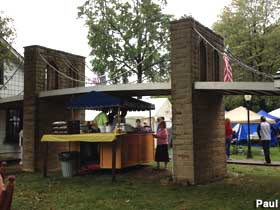
Posted on 11/26/2017 8:46:53 AM PST by Kaslin
AN APPLE A DAY may or may not keep the doctor away, but it's a sentiment shared by just about everyone our Mo Rocca has been visiting:
At the Johnny Appleseed Festival in Fort Wayne, Ind., there's no such thing as a bad apple. There you can indulge in apple dumplings -- a skinless apple wrapped in dough, and deep-fried.
Rocca asked, "How healthy is this?
"Very healthy -- it's an apple!" he was told
Or partake of apple petals ("Better than apple dumplings!" enthused cutthroat vendor Logan Forbing), and sample some apple sausages.
Fort Wayne is where John Chapman -- better known as Johnny Appleseed -- died more than 170 years ago. Johnny is buried here -- at least, the locals like to think so. According to author Howard Means (who wrote a book about the real Johnny Appleseed), "It's very questionable it's in fact the grave of John Chapman."
Turns out there is much that's misunderstood about the man many of us came to know through the 1948 Walt Disney cartoon.
(Excerpt) Read more at cbsnews.com ...
Many (if not most) of the juices on the market in the US today that say 100% fruit juice are correct because they contain 80% apple juice most of which is imported from China.

After the enviro-wackos succeeded in destroying the US apple industry in the 80 over the fake alar scare, and all the apple farmers began to rip out their trees and simultaneously the wackos forced legal diversion of irrigation water from the Columbia River. the farmers no long not only had no markets, but no water for the trees.
Enter the Chinese ... at about that point, it became cheaper to import Chinese potatoes to Idaho them to ship Idaho potatoes anywhere ...
See how that works?
John Chapman was real...he was born in Leominster, Massachusetts in 1774.
One of his apple trees is still standing on the SUNY campus next to Syracuse University in Upstate NY. He was a real guy.
The decision not to use animal labor on the farm proved to be the undoing of the commune, combined with the fact that many of the men of the commune spent their days teaching or philosophizing instead of working in the field. Using only their own hands, the Fruitlands residents were incapable of growing a sufficient amount of food to get them through the winter.
More Spahn Ranch than Walden Pond. There is no direct connection between Alcott and the Fruitlands commune and John Chapman. This is the replica of Chapman's cabin, which is actually on what is now a suburban cul-de-sac:

I’ve read that JA was also aiding settlement, something about moving a few years in advance of the front of the westward expanding frontier, planting apple seeds helped with a legal requirement that settlers had to build a structure and put in a crop as part of improving the land to qualify for homestead rights.
______
Speaking of replicas, here is a replica of Roebling's Brooklyn Bridge in Saxonburg, Pa.

That is one heck of an apple tree!
Disclaimer: Opinions posted on Free Republic are those of the individual posters and do not necessarily represent the opinion of Free Republic or its management. All materials posted herein are protected by copyright law and the exemption for fair use of copyrighted works.